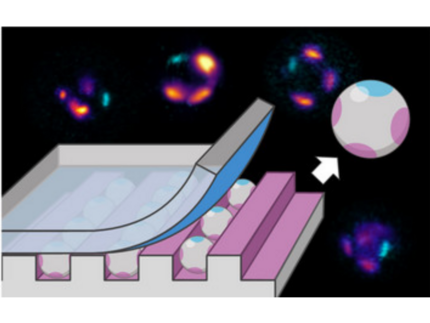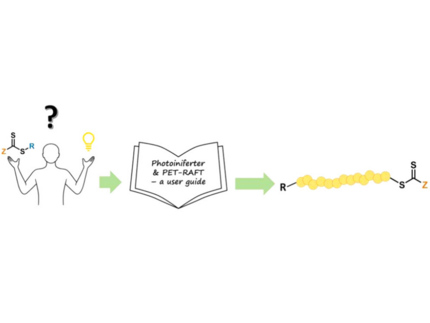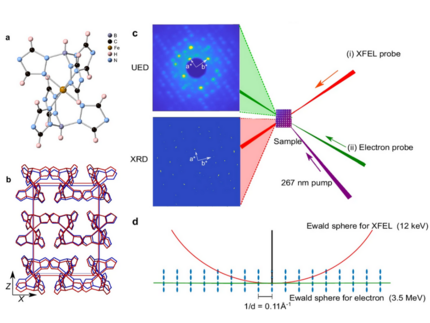M. Reifarth, M. Sperling, R. Grobe, P. Akarsu, F. Schmitt, M. Schmette, S. Tank, K. M. Arndt, S. Chiantia, M. Hartlieb, A. Böker
Regioselective and Anisotropic Multi-Patching of Small Microparticles via a Polymer Brush-Assisted Microcontact Printing (µCP)
Advanced Functional Materials, 2025, 2423495
A method for fabricating anisotropic monodisperse silicon dioxide (SiO2) patchy microspheres is developed. In the protocol, we utilize a modified microcontact printing (µCP) technique, employing a polydimethylsiloxane (PDMS) elastomer with a regularly grooved surface topography as a stamp. The stamp's microscale channels create a confined environment for the SiO2 microspheres, as they match the particle dimensions (≈4 µm). The solid-phase µCP routine allows for the transfer of functional trialkoxysilanes from the stamp to the particles exclusively at their contact faces. By applying a second stamp to the exposed side of the particles, a fourth patch with different chemical information is added, resulting in particles with four equidistant patches along the particle equator. This fabrication process, compatible with a manifold follow-up chemistry, adds patches with adjustable characteristics. Consequently, a polymeric material containing the nucleobase adenine, is successfully added to the patches, which enables interactions with materials that possess its complementary base uracil. The method is suitable to fabricate particles possessing a C4v and C2v symmetry. Importantly, the protocol is easily adaptable to other particle dimensions and surface chemistry, possessing significant potential in the field of anisotropically functionalized spherical colloidal particles.
M. A. Beres, C. Boyer, M. Hartlieb, D. Konkolewicz, G. G. Qiao, B. S. Sumerlin and S. Perrier
RAFT with Light: A User Guide to using Thiocarbonylthio Compounds in Photopolymerizations
This perspective offers an in-depth guide to photopolymerizations mediated with thiocarbonylthio compounds, with a particular focus on photoiniferter and photoinduced energy/electron transfer RAFT (PET-RAFT) polymerizations, focusing on practical considerations. It is designed to provide both newcomers and experts with the practical knowledge needed to harness light-mediated polymerizations for innovative applications. The discussion begins with an overview of conventional RAFT polymerization and proceeds to highlight the distinctive advantages of the photomediated processes. The photochemical behavior of thiocarbonylthio compounds, along with the selection of appropriate light wavelengths, is critically examined for its impact on polymerization kinetics and optimization of polymer properties. Key parameters influencing polymerization success─such as catalyst selection, solvent choice, light intensity, and temperature─are explored in detail. The importance of oxygen tolerance and end-group fidelity is also addressed, as these factors are essential for achieving well-defined polymers. Additionally, reactor configurations are reviewed, focusing on the roles of light sources, reactor geometry (batch versus flow systems), and temperature control in optimizing the reaction efficiency. The article concludes by integrating these concepts into a comprehensive framework for optimizing photoiniferter and PET-RAFT polymerizations.
D. Vinci, K. Ridier, F. Qi, F. Ardana-Lamas, P. Zalden, L. Chung Liu, T. Eklund, M. Sielemann Jakobsen, R. Schubert, D. Khakhulin, C. Deiter, N. Bottin, H. Yousef, D. von Stetten, P. Łaski, R. Kamiński, K. N. Jarzembska, R. F. Wallick, T. Stensitzki, R. M. van der Veen, H. Müller-Werkmeister, G. Molnár, D. Xiang, C. Milne, M. Lorenc and Y. Jiang
Capturing ultrafast molecular motions and lattice dynamics in spin crossover film using femtosecond diffraction methods
Nature Communications, 2025, 16, 2043
A comprehensive insight into ultrafast dynamics of photo-switchable materials is desired for efficient control of material properties through light excitation. Here, we study a polycrystalline spin crossover thin film as a prototypical example and reveal the sequential photo-switching dynamics, from local molecular rearrangement to global lattice deformation. On the earliest femtosecond timescale, the local molecular structural rearrangement occurs within a constant unit-cell volume through a two-step process, involving initial Fe−ligand bond elongation followed by ligand rotation. The highly-oriented structure of the nanocrystalline films and the experimental geometry enables resolving the full anisotropic lattice structural dynamics in and out of the sample plane separately. While both molecular switching and lattice heating influence lattice volume, they exert varying degrees of impact at disparate time scales following photoexcitation. This study highlights the opportunities provided by Mega-electron-volt electron and X-ray free electron laser to advance the understanding of ultrafast dynamics of photo-switchable materials.



